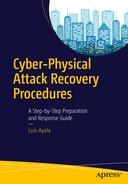Chillers are not as dangerous as steam boilers or pressure vessels, but a hacker can wreak havoc with your chillers if he knows what he’s doing. The old absorption chillers generated hydrogen gas naturally as a result of the reaction of lithium bromide with the steel surfaces of chiller, but they are not very common anymore. A hacker attempting to disrupt the chilled water system will generally mess with the refrigerant flow or the condenser water temperature. If a hacker can cause the pressure differential (lift) to exceed the capacity of the compressor, the backward pressure flow causes the chiller to surge. Conversely, if the hacker can cause the pressure in the evaporator to drop, that can also cause the compressor to surge. If the compressor surges, you’ll know because it is very noisy.
The cooling tower can also cause the compressor to surge with reduction in the flow of water to the condenser. If the cooling tower fan stops, you will get a high temperature condition. Of course, the hacker would have to defeat the low temperature safety switch, so it does not shut down the chiller automatically. Chiller surge causes damage to the rotating assemblies. When a second or lag machine must be started, the timing of the isolation valves is crucial in preventing a surge condition. If the valve does not open after 90 seconds, the lag system automatically shuts back down in a failure mode.
Rupture disc
A non-reclosing pressure relief device that typically protects a pressure vessel, equipment, or system from over pressurization or potentially damaging vacuum conditions, also known as a pressure safety disc, a burst disc, a bursting disc, or a burst diaphragm.
If a hacker shuts down the chiller and leaves the pump on, the water in the system heats up increasing the pressure on the cooling side of the chiller. That will increase the pressure in the chamber causing the rupture disc to fail, releasing the refrigerant into the atmosphere. If the refrigerant is R-11, maintenance personnel can be overcome and being unable to breathe possibly pass out from lack of oxygen. This is not the case with R-34 refrigerant. Of course, repairing the rupture disc and replacing lost refrigerant takes time. You should be back up and running in a couple days (provided you have a preferred maintenance agreement with the vendor). That is unless, of course, there were 600,000 buildings attacked simultaneously.
Troubleshooting Chillers
Begin by looking for indicators or codes that come up on the diagnostic readouts.
Make a visual inspection of the electrical panel, water piping, and pump tank system. Look for obvious problems such as burned or broken wires, water pump not running, water valves shut off, and improper system water temperature.
Is the chiller running and not cooling, or not running at all?
Is the pump circulating water? What is the water temperature?
If the chiller isn’t running, check the high voltage circuits.
Does the chiller have power? Check all the fuses.
Start at the power side of the control transformer and check wire by wire.
Trace the power wire from safety to safety.
Check the water flow switch and the freezestat control.
Strap temperature probes on the suction, discharge, and liquid lines.
Watch all the pressures, temperatures, and amperages.
Chiller Cyber-Attack Tree
The following are some simple hacks that the attacker may use:
Low-pressure trip: BCS thinks that the refrigerant is low; has low or no water flow; or has a clogged water filter or screen.
High-pressure trip: BCS thinks that the water-cooled condenser has poor or no flow; the air-cooled condenser is blocked with debris or has a fan not working; or that the chilled water tank temperature is too high.
Oil failure trip: BCS thinks that there is either low superheat or low oil.
Freezestat: BCS thinks that there is poor water flow or that the thermostat is set too low.
Blown fuses or starter trips: BCS thinks that there is an over-amped motor, compressor, or wires.
System not reaching thermostat setpoint: BCS thinks that the evaporator is iced up.
Proof of flow: BCS thinks that the flow or pressure switches in water circuit are suffering from low or no flow, or that the water filter is blocked or the water valve is shut off .
